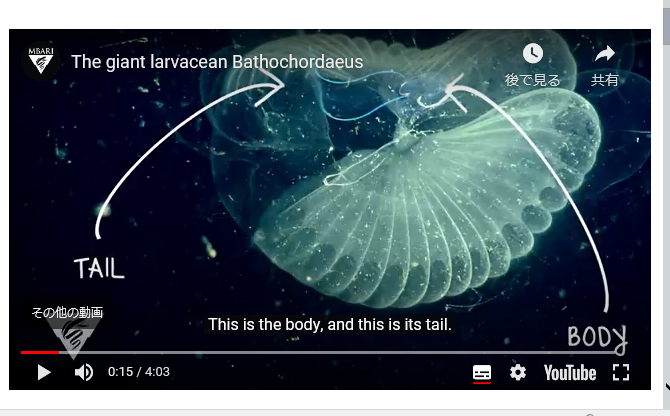ジェリー状の2層構造を持つ深海の生き物
1900年に発表されて以来、決定的な目撃情報がなかった謎の生物の存在が、ついに確認されたそうです。 2016年のこと。
何とも生物は未知であふれていますねぇ。
海の生物、特にクラゲ、大好きです。時間を忘れていつまでも見ていたい。
”やっぱり、生物は海からきたのね” 海に水に見せられる自分を発見するとき、
いつもそんなことを感じます。母なる海!!!
今日はその神秘に触れてみましょう!!!
- 科学者たちが体液の住処となる海の生物を研究
- Bathochordaeus オタマボヤ
- 原文
- Scientists Study Sea Creature Which Makes a Home of Body Fluid
- Words in This Story
科学者たちが体液の住処となる海の生物を研究
Scientists Study Sea Creature Which Makes a Home of Body Fluid
いくつかの非常に小さな深海生物は、海の建築家として知られています。彼らは、保護の提供と食物を捕獲する複雑な家を建てることができるのです。これらの構造物は、それらの頭から出てくる液体でできています。
構造物が使い切られると、その生物はー巨大幼虫と呼ばれるー新しいものを作ります。通常、これは毎日行われます。
ある人は、これらの家を ”鼻水の宮殿” と呼びます、それは、保護のために生体組織によって生成された液体で作られた大きな家のようだからです。
幼虫の家を研究することで、科学者がどのようにして家を作っているのかを理解できれば、建築業界に役立つのではないかと考える人もいます。その一人が、カリフォルニア州にあるモンテレーベイ水族館研究所の生物工学者、カカカニ・カティヤ氏です。
彼女のチームは最近、ネイチャー誌にいわゆる ”鼻水の家” についての調査結果を発表しました。
これらの家の中にいる生き物は小さく--最大のものは10センチほですが、環境にとって重要な存在です。彼らは世界中の海に住んでいます。カティヤ氏や他の科学者たちは、彼らは背骨のない人間に最も近い親戚だと述べています。
「彼らは、ほぼ完全に水から作られたエイリアンの生命体のようなものですが、巧妙でありながら、複雑で目的を持って作られています。」と、ダルハウジー大学の海洋生物学者ボリス ワーム 氏は指摘します。 彼はこの研究には参加していませんでした。
その生き物はまた、海洋環境を助けるのだとワーム氏は言います。彼らの家が使用されているとき、彼らは海底に数百万トンもの炭素を落とすのです。そしてそれは地球温暖化を防ぐためにそこに留まっているというのです。
幼虫は水中からマイクロプラスチックを取り出して海底に置きます。さらに、彼らの家の中の廃棄物は、海底に住んでいる生き物によって食べられるのです。
彼らが何を作っているのかは、科学者にとっては興味があり、謎のままです。なぜなら、粘液の家は非常に細かく、壊れやすいため、研究者は研究のために研究室に持って行くことができないからです。そこで、カティヤ氏と彼女のチームは、ロボット潜水艦、カメラ、レーザーを使って、カリフォルニア州のモントレー湾の近くの水深200~400メートルの水の中で、この生物を観察しました。
これらの粘液構造は単純ではありません。彼らは食物を捕らえる2つの心臓のような領域を持っています。粘液ハウスはほとんど透明で、幼虫を完全に覆っていることが多いのです。
そして、この家は生き物自身の10倍以上の大きさがあります - 大きさは1メートル以上に達します。人が5階建ての家を作るのと同じだろう、とカティヤ氏は指摘します。
水は構造物を通って流れることができるので、水を通って来るとき、幼生は自分たちを食べるかもしれない魚から隠れた状態になります。
月の上の構造物構築を探しているNASAのエンジニアは、おそらく幼生について学びたいのじゃないかしら、とカティア氏は言います。
カティヤ氏のチームは、レーザーを使って粘液ハウスの内部の構造を研究しました。
その後、研究者たちは、構造体の内部構造をモデル化するために、コンピュータ・ソフトウェアを使ってそれを再現しました。しかし、彼女は、科学者たちはすべてのことを理解するにはまだほど遠いと言います。
ロードアイランドにあるプロビデンス大学の生物学者ジャック・キャロル氏は、この研究には参加していませんでしたが、この研究については良いことを言っています。彼は、カティヤのチームは有用な仕事をしたと。
「私たちは学ぶべきことがたくさんあります。」とキャロル氏は言います。そして、「私はこの動物たちに畏敬の念を抱いています。」と。
Bathochordaeus オタマボヤ
上の画像:本体は10センチ足らずのオタマじゃくしのような形態。
からだと尻尾を示してます。
下の画像:上の物体をとりまくゼリー状の構築物。
つまり2層構造をしています。


ですから、この生き物はタンパク質とセルロースの2層構造「家」を身にまとい、その直径は1メートルを超えるといいます。使い捨ての家は水中を漂う微粒子状の餌をとらえ、ろ過するフィルターとしての役目を果たし、フィルターが目詰まりを起こしたら、家ごと捨て去り、ときにはものの数時間で新しい家をつくってしまうそうです。
詳細は☟
何とも生物は未知であふれていますねぇ
原文
Scientists Study Sea Creature Which Makes a Home of Body Fluid
 This 2002 photo provided by the Monterrey Bay Aquarium Research Institute shows a close up view of a "giant larvacean" and its "inner house" - a mucus filter that the animal uses to collect
This 2002 photo provided by the Monterrey Bay Aquarium Research Institute shows a close up view of a "giant larvacean" and its "inner house" - a mucus filter that the animal uses to collect
Some very small, deep sea creatures are known as the master builders of the sea. They can build complex homes that provide protection and capture food. These structures are made from a fluid that comes out of their heads.
When the structures get used up, the creatures — called giant larvaceans — build a new one. Usually this takes place every day.
Some people call these homes “snot palaces” because they are like big houses made of mucus, a fluid produced by living tissue for protection.
Some people think studying larvaceans’ homes could help the building industry if scientists can understand how they make them. One of those people is Kakani Katija, a bioengineer at Monterey Bay Aquarium Research Institute in California.
Her team released its findings on the so-called “snot houses” in Nature magazine recently.
The creatures inside these houses are small — the biggest ones are around 10 centimeters, but they are important to the environment. They live in oceans around the world. Katija and other scientists said they are the closest relatives to human beings without a backbone.
“They are like an alien life form, made almost entirely out of water, yet crafted with complexity and purpose,” noted marine biologist Boris Worm of Dalhousie University. He was not part of the study.
Worm said the creatures help the ocean environment also. When their homes are used up, the creatures drop millions of tons of carbon to the seafloor. It stays there preventing global warming, he said.
Larvaceans take microplastics out of the water and put it on the sea floor. In addition, the waste in their homes is eaten by creatures living at the bottom of the ocean.
What they build interests and remains a mystery to scientists. Because the mucus houses are so fine and easily broken, researchers are unable to take them to a laboratory for study. So, Katija and her team used a robot submarine, cameras, and lasers to watch the creatures in waters 200 to 400 meters deep near California’s Monterey Bay.
These mucus structures are not simple. They include two heart-like areas that capture food. The mucus houses often are nearly clear and completely cover the larvaceans.
And the houses are 10 times bigger than the creatures themselves — reaching more than one meter in size. It would be the same as a person making a five-story house, Katija noted.
Water can flow through the structure so that, when it comes through the water, the larvacean stays hidden from fish that might eat it.
Katija said NASA engineers looking to build structures on the moon would probably like to learn about the larvaceans.
Katija’s team used a laser to study the structure of the inside of the mucus houses.
Then, the researchers recreated it with computer software to model the inner workings of the structure. But she said the scientists are still far from understanding everything going on.
Biologist Jack Carroll of Providence College in Rode Island was not part of the study, but had good things to say about it. He said Katija’s team did useful work.
“We have a lot to learn,” Carroll said. “I’m in awe of these animals.”
_______________________________________________________________
Words in This Story
master – adj. having or showing great skill
snot – n. fluid that comes from the nose and other tissue
alien – adj. foreign
crafted – adj. something made with care, requiring a special skill
global – adj. related to the whole world
NASA – n. short for the National Aeronautics and Space Administration; the U.S. space agency
awe – n. a strong feeling of wonder

